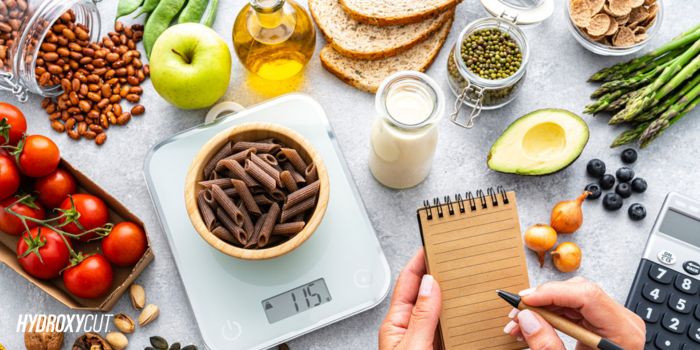Carbs, the oft-demonized macronutrient, is back in the spotlight – but with a twist.
Enter carb cycling, a dietary strategy that involves strategically varying your carbohydrate intake throughout a set period, like daily, weekly, or monthly.
This approach has gained traction among athletes, fitness enthusiasts, and even those simply looking to manage their weight.
But is it all it's cracked up to be? Let's delve into the world of carb cycling, exploring its potential benefits, drawbacks, and how to implement a 7-day carb-cycling Plan (if it suits your needs).
Table of content
Understanding Our Energy Source: The Carbohydrates
Carbohydrates are the body's primary source of energy.
They break down into glucose, which fuels our muscles, brain, and various bodily functions.
Different types of carbs exist, with complex carbs (whole grains, vegetables) offering sustained energy and fiber, while simple carbs (sugary drinks, refined grains) provide a quick but fleeting energy boost.
Our bodies store excess carbohydrates as glycogen, primarily in the muscles and liver.
When we consume carbohydrates, our glycogen stores replenish. Conversely, when carb intake is low, the body dips into these stores for energy.
Also Read: Upper Ab Workouts - The True Guide
The Carb Cycling Theory
It is a dietary approach that involves alternating carbohydrate intake on different days or throughout the week (7-day Carb-cycling plan). It's a popular strategy among athletes, bodybuilders, and individuals seeking to optimize their body composition and performance while managing their energy levels effectively.
The core principle behind carb cycling is to strategically manipulate carbohydrate intake to achieve specific goals, such as fat loss, muscle gain, or improved athletic performance. This approach recognizes that carbohydrates are a primary source of energy for the body, especially during high-intensity exercise and activities.
Carb cycling proposes that manipulating carb intake can optimize various fitness goals. Here's the core idea:
Also Read: 10 Superfoods for Weight Loss
1. High-Carb Days
- On high-carb days, individuals consume a higher proportion of carbohydrates in their diet. These days are often aligned with intense training sessions or periods of increased physical activity.
- High-carb days help replenish muscle glycogen stores, providing the energy needed for rigorous workouts and supporting optimal performance.
- Foods rich in complex carbohydrates such as whole grains, fruits, vegetables, and legumes are prioritized on high-carb days.
2. Low-Carb Days
- Conversely, low-carb days involve reducing carbohydrate intake, often below the individual's usual daily consumption.
- On low-carb days, the focus shifts towards consuming higher amounts of protein and healthy fats while limiting carbohydrate-rich foods.
- Low-carb days are commonly scheduled on rest days or during periods of lighter activity when the body's energy demands are lower.
- By restricting carbohydrates, the body may rely more on fat stores for fuel, potentially facilitating fat loss and improving metabolic flexibility.
3. Moderate-Carb Days
- Some carb cycling protocols incorporate moderate-carb days, where carbohydrate intake falls between the levels of high and low-carb days.
- Moderate-carb days offer a balanced approach, providing sufficient energy for moderate-intensity activities without excessive carbohydrate consumption.
- These days help maintain metabolic flexibility and prevent the negative effects associated with long-term low-carb diets, such as metabolic slowdown and hormonal imbalances.
The specific structure of carb cycling can vary based on individual goals, preferences, and metabolic responses.
Also Read: How to Lose Weight After 40?
A Breakdown of Macronutrients
Many weekly or 7-day carb cycling plans follow a 2:2:3 approach:
- 2 high-carb days,
- 2 moderate-carb days, and
- 3 low-carb days.
This strategy focuses on manipulating carbohydrate intake throughout the week.
Protein: The amount of protein you consume typically stays consistent across all days, regardless of carb intake. Protein is crucial for building and repairing tissues, so maintaining a steady intake is important.
Fats: Here's where things get interesting! Fat intake changes based on how many carbs you're eating on a particular day.
- High Carb Days: Since you're consuming more carbs, these days are typically lower in fat. This ensures your body prioritizes using the readily available carbohydrates for energy.
- Low Carb Days: With fewer carbs on the menu, your body relies more on fat for fuel. To compensate for the lower carb intake, fat intake increases on these days.
Factors such as activity level, training intensity, body composition, and metabolic rate influence the design of a carb cycling regimen, with some focusing on daily fluctuations, while others adopt a weekly approach with high-carb days strategically placed around workouts.
Also Read: How to find balance in life?
Potential Benefits of Carb Cycling
Carb-cycling boasts several advantages:
- Enhanced Fat Loss: By creating periods of low carb intake, carb cycling may promote the body to tap into fat stores for energy, potentially aiding weight loss efforts.
- Improved Athletic Performance: High-carb days ensure adequate glycogen stores for high-intensity workouts, potentially leading to better performance and faster recovery.
- Boosted Metabolism: The theory suggests that alternating carb intake can prevent the metabolism from adapting to a constant level of carb intake, potentially leading to a more efficient calorie burner.
- Appetite Control: Some find that low-carb days curb sugar cravings and lead to a more controlled appetite.
However, research on the effectiveness of carb cycling for weight loss and athletic performance is ongoing and somewhat inconclusive. Some studies suggest potential benefits, while others show no significant difference compared to other dietary approaches.
Carb cycling isn't just about shedding pounds. By alternating low and high carb days, you might experience some additional benefits:
Low Carb Perks
- Better Insulin Sensitivity: Your body becomes more efficient at using insulin, a hormone that helps regulate blood sugar.
- Increased Fat Burning: Utilization: With fewer carbs on board, your body turns to fat stores for energy.
- Improved Cholesterol Levels: Low-carb periods might positively impact your cholesterol profile.
- Enhanced Metabolism: Your body's calorie-burning furnace might get a boost.
High Carb Refuel Perks
- Hormonal Hunger Harmony: High-carb days might positively influence hormones like thyroid, testosterone, and leptin, which play a role in metabolism, hunger, and exercise performance.
- Reduced Inflammation: Carb refeeds might help keep inflammation in check.
- Improved Iron Utilization: High-carb periods could aid your body's ability to use iron.
Remember: While these benefits sound promising, there are also downsides to consider, like the complexity of following the plan and the lack of long-term research on its safety and effectiveness.
Carb Cycling: Is It Right for You?
Before diving into carb cycling, consider these factors:
- Your Fitness Goals: Are you a seasoned athlete seeking a performance edge, or someone looking for a more sustainable weight management approach? Carb cycling might be more suitable for athletes with specific training goals.
- Your Lifestyle: Carb cycling requires planning and discipline to manage varying carb intake. If a complex dietary approach doesn't fit your lifestyle, a simpler, balanced diet might be more sustainable.
- Your Health: If you have any underlying health conditions, consult a doctor or registered dietitian before embarking on carb cycling.
Also Read: How to Start Lifting Weights?
Implementing Carb Cycling (if it suits you)
Here's a basic framework to get you started (remember, individual needs may vary):
- Identify Your Goals: Determine if carb cycling aligns with your fitness aspirations.
- Choose a Carb Cycling Protocol: Daily, weekly, or monthly variations exist. Research different approaches and choose one that suits your training schedule.
- Calculate Your Carb Needs: Aim for a moderate baseline carb intake and adjust it up or down based on your chosen protocol (high, low, moderate days). There are online calculators and resources to help.
- Focus on Whole Foods: Prioritize complex carbs like whole grains, vegetables, and fruits on all carb intake levels.
- Listen to Your Body: Pay attention to your energy levels, performance, and hunger cues. Adjust your carb intake as needed.
Sample Carb Cycling Week
Monday
- Exercise: Weight Training
- Carb Intake: High (200g)
- Fat Intake: Low
Tuesday
- Exercise: Aerobic Exercise
- Carb Intake: Moderate (100g)
- Fat Intake: Moderate
Wednesday
- Exercise: Rest Day
- Carb Intake: Low (30g)
- Fat Intake: High
Thursday
- Exercise: Weight Training
- Carb Intake: High (200g)
- Fat Intake: Low
Friday
- Exercise: Weight Training
- Carb Intake: High (200g)
- Fat Intake: Low
Saturday
- Exercise: Rest Day
- Carb Intake: Low (30g)
- Fat Intake: High
Sunday
- Exercise: Rest Day
- Carb Intake: Low (30g)
- Fat Intake: High
7-Day Vegetarian (Egg included) Carb Cycling Meal Plan (Sample)
This sample plan outlines a vegetarian carb cycling approach with a focus on whole, unprocessed foods.
Daily Staples:
- Aim for at least 2-3 servings of vegetables with each meal.
- Include healthy fats like avocado, nuts, seeds, and olive oil throughout the day.
- Drink plenty of water throughout the day to stay hydrated.
Day 1 (HC):
- Breakfast: Oatmeal (rolled oats) with berries, nuts, and a drizzle of honey
- Lunch: Veggie wrap with whole-wheat tortilla, hummus, roasted vegetables, and avocado
- Dinner: Vegetarian chili with brown rice and a side salad
- Snack: Greek yogurt with fruit and granola (optional)
Day 2 (MC):
- Breakfast: Whole-wheat toast with eggs and spinach
- Lunch: Lentil soup with a side salad
- Dinner: Tofu stir-fry with brown rice and mixed vegetables
- Snack: Apple slices with almond butter
Day 3 (LC):
- Breakfast: Scrambled eggs with spinach and a side of cherry tomatoes
- Lunch: Veggie burger salad with mixed greens, avocado, and a light vinaigrette dressing
- Dinner: Grilled tofu with roasted vegetables and quinoa
- Snack: Cottage cheese with chopped vegetables
Day 4 (HC):
- Breakfast: Whole-wheat pancakes with berries and a splash of maple syrup
- Lunch: Black bean burger on a whole-wheat bun with sweet potato fries
- Dinner: Vegetarian lasagna with whole-wheat noodles and vegetables
- Snack: Trail mix with nuts, seeds, and dried fruit (optional)
Day 5 (MC):
- Breakfast: Smoothie made with Greek yogurt, spinach, banana, and almond milk
- Lunch: Vegetarian sushi with brown rice and avocado
- Dinner: Veggie fajitas with whole-wheat tortillas, grilled vegetables, and black beans
- Snack: Handful of almonds and dried cranberries
Day 6 (LC):
- Breakfast: Omelet with mushrooms, peppers, and cheese
- Lunch: Chickpea salad sandwich on whole-wheat bread with lettuce and tomato
- Dinner: Cauliflower rice with sauteed vegetables and tofu scramble
- Snack: Celery sticks with peanut butter
Day 7 (Rest or Low-Intensity Activity):
- Breakfast: Whole-wheat toast with avocado and a poached egg
- Lunch: Large salad with chickpeas, quinoa, chopped vegetables, and a light vinaigrette dressing
- Dinner: Vegetarian lentil stew with a slice of whole-grain bread
- Snack: (Optional) Cottage cheese with a sprinkle of berries
Also Read: Health First - What to Pack for Lunch?
7-day carb cycling plan for a non-vegetarian diet (Sample)
Day 1: High-Carb Day
- Breakfast: Oatmeal topped with sliced bananas and almonds.
- Snack: Greek yogurt with berries.
- Lunch: Grilled chicken breast with quinoa and roasted vegetables.
- Snack: Apple slices with peanut butter.
- Dinner: Baked salmon with sweet potato and steamed broccoli.
Day 2: Low-Carb Day
- Breakfast: Scrambled eggs with spinach and feta cheese.
- Snack: Celery sticks with hummus.
- Lunch: Turkey lettuce wraps with avocado and cucumber slices.
- Snack: Cottage cheese with cherry tomatoes.
- Dinner: Stir-fried shrimp with zucchini noodles and bell peppers.
Day 3: Moderate-Carb Day
- Breakfast: Protein smoothie with spinach, banana, protein powder, and almond milk.
- Snack: Handful of mixed nuts.
- Lunch: Grilled steak salad with mixed greens, tomatoes, and balsamic vinaigrette.
- Snack: Sliced mango with cottage cheese.
- Dinner: Baked chicken thighs with quinoa pilaf and roasted asparagus.
Day 4: High-Carb Day
- Repeat Day 1 menu.
Day 5: Low-Carb Day
- Repeat Day 2 menu.
Day 6: Moderate-Carb Day
- Repeat Day 3 menu.
Day 7: High-Carb Day
- Repeat Day 1 menu.
Tips:
- Feel free to swap ingredients based on your preferences and dietary needs.
- Adjust portion sizes based on your individual calorie requirements.
- Include protein sources like tofu, tempeh, lentils, beans, eggs, and dairy (if you consume it) throughout the week.
- Don't forget to stay hydrated with water throughout the day.
- Consider using a calorie-tracking app to monitor your intake and ensure you're meeting your nutritional needs.
Also Read: Healthy Snack Preparation
While these sample plan provides a general idea, remember:
- Find Your Perfect Fit: Consider consulting a registered dietitian to personalize a carb cycling plan with specific carb amounts tailored to your needs and goals.
- Listen to Your Body: If you have any underlying health conditions, especially diabetes, or take medications, consult your doctor before starting carb cycling. They can advise you on whether it's safe and recommend adjustments to fit your specific situation.
Remember: Carb cycling is not a magic bullet. It requires planning, and discipline, and may not be suitable for everyone. Consulting a registered dietitian can help you create a personalized plan that aligns with your health and fitness goals.
Read Our Most Read Content:
Safe & Effective Weight Loss Products
Hydroxycut is safe for healthy adults to use as directed on the label.



